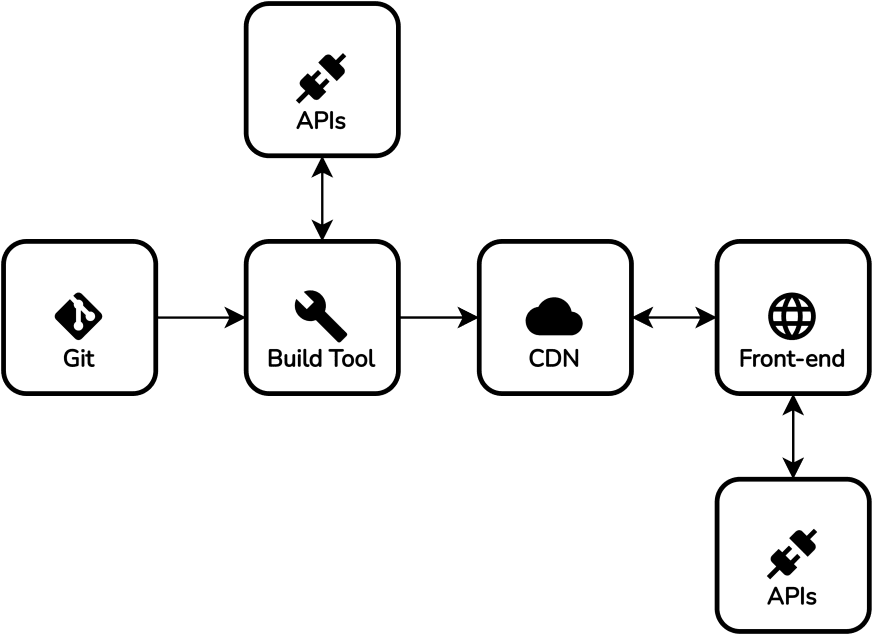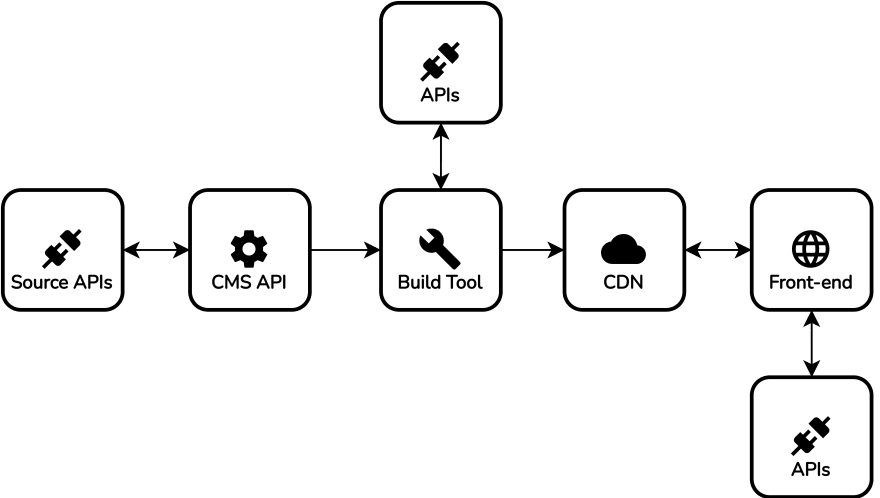An Interest In:
Web News this Week
- April 16, 2024
- April 15, 2024
- April 14, 2024
- April 13, 2024
- April 12, 2024
- April 11, 2024
- April 10, 2024
Git-based vs API-first CMS
Content management system (CMS) platforms have been at the forefront of content creation for nearly two decades. However, a lot has changed since the release of WordPress in 2004. New technologies have been introduced and CMSs have evolved, decoupling where the content is managed from where its displayed.
Even though WordPress is still in high use, it has a lot of drawbacks. To achieve better performance, higher reliability, greater security, and the freedom of displaying your content wherever and however you want, you may need to move to a headless CMS.
To do that, youll need first to decide which type of headless CMS you want to useGit-based or API-driven?
In this post Ill compare both types of headless CMS platforms, focusing on the differences between them, the pros and cons, and the use cases, to help you make your decision.
How Do Headless CMSs Work?
To better understand different types of CMSs, you first have to know the technologies that power them.
Git-Based
Git-based CMSs are built upon the Git version control system (VCS).
Git stores your files and their history of changes in a repository. It allows you to branch out, merge, clone, react to changes, and in general easily manage your contentespecially the text element.
In a Git-based CMS, you manage your content through mentioned Git functionalities or the Git-powered editor right in your CMS. Then, on selected changes, the CMS processes the new or updated content and automatically builds and updates your frontend (website or app, for instance). Thats usually done through integration with large Git providers like GitHub or GitLab.
API-First
API-first CMSs work as unified pieces of software, serving content through an Application Programming Interface (API).
Developers can use the API (usually REST or GraphQL) to build the required frontend or other types of integrations. Reactions to specific updates and other outputs from the CMS also need to be directly handled.
The content storage, editor, and general management are all handled by the CMS.
If You Use a Git-Based CMS
Each type of headless CMS offers benefits and drawbacks. Here are the pros and cons of a Git-based CMS. As youll see, its biggest strengths and weaknesses come from the Git VCS powering it.
Pros
- The baked-in features of Git: Full version control, auto backup, clean control structure.
- Integrated development: As Git is already the go-to VCS for software development, its easy to keep your frontend code right beside your content, keeping everything centralized.
- No lock-in: Git is an open-source tool and industry standard allowing you to switch between Git cloud providers and Git-based CMSs relatively easily.
- Easy setup: Especially if youre already used to working with Git, setting up Git-based CMS is relatively simple.
Cons
- A limited number of front-ends: Due to its implementation as Git integration, a Git-based CMS doesnt scale well for multiple, especially diverse, frontends.
- Hard to use with complex or frequently updated content: Git is also not a place for frequent live content and heavy static assets due to its update model and the Git architecture, respectively.
- Limited querying options: It depends on the CMS, but Git-based platforms usually have limited data querying options, limiting the front-end customization potential.
If You Use an API-First CMS
The advantages and disadvantages of API-first CMSs vary greatly from the Git-based CMSs. Not only are they based on a different foundation, but as unified pieces of software, they can be different even from each other.
Because of this, some API-first CMS platforms might have pros and cons that others might not have. Still, some general points apply to most of them.
Pros
- Well-suited for multiple frontends: Single, headless CMSs can easily serve different frontends with the help of API.
- Great customizability and choice: As API-first CMSs are usually built from the ground up, there are many solutions available to choose from. You can even build custom CMSs on top of more advanced APIs.
- Easily handles large data: This might vary depending on the CMS, but API-first platforms can usually handle larger data sets than Git-based platforms.
- Can handle frequently updated content: Without Git in the way, updates can be delivered quickly and even more specifically designed.
Cons
- No Git features guaranteed: Since Git isnt part of the CMS architecture, you have to think twice about things like versioning or backup.
- Storage and usage limits: As API-first CMSs are more integrated, you can expect them to come with costly limits on storage and usage.
- Fewer formatting options: As with all locked-in CMSs, youll be limited only to the formatting options youre given.
- More dependent on developers: Even though API is great for custom frontends, it requires more custom handling and developer involvement.
Opportunities and Challenges
Each type of headless CMS presents opportunities and challenges to the developer. How can you make the most out of either a Git-based or API-first CMS, and what bottlenecks can you expect as you go?
The Power of Git-Based CMSs
The benefits of powering a CMS through Git cannot be understated.
From the start, youll be working with a system youre probably very familiar with. From version control to its open-source nature and multiple integrations to content formatting flexibility, youve got everything you need to set up all kinds of great websites quickly.
SEO and Scalability
However, with content format flexibility also comes more responsibilities, like handling SEO optimizations yourself. Thats something API-first CMSs will often do automatically.
As for scalability, when going with a Git-based CMS, consider the future of your product. Plan the correct content format ahead of time. Know what frontends youll need to handle, how large your data set will get, and whether youll host frequently updated content, among other issues. A Git-based CMS doesnt scale well for certain medium and larger or multiple frontends, so keep this in mind.
The Flexibility of API-First CMSs
Using an API-first CMS allows access to opportunities that arent possible with Git. Its much more scalable, can drive multiple diverse frontends, and can even integrate with unique consumer devices like smart speakers. With API, you can do pretty much anything given enough time and the right tools.
Additionally, API-first CMSs are better suited for handling heavy static assets and frequent content updates. Even if thats not something you need currently, its important to consider as your content grows.
Developer-Heavy and Higher Costs
A drawback to all those API benefits is the fact that it drives higher reliance on developers. Whether thats a deal breaker or not depends on your situation and use case.
API-first CMSs offer a more closed, proprietary model than Git, and along with that come higher costs. However, the amount and quality of provided services might be worth it for your use case.
Use Cases
Speaking of use cases, what exact products and services can you develop with either headless CMS?
Static Websites
Static websites are among the most popular sites for coupling with headless CMSs. For all the blogs, landing pages, newsletter pages, documentation, and other elements, both Git-based and API-first CMSs will work wellparticularly the Git-based ones, given their simplicity and fast setup.
E-Commerce
The type of CMS recommended for e-commerce sites will vary depending on how often you need to update your content. For simple, infrequently updated, small- to medium-sized stores, a Git-based CMS will do just fine. If youre looking at scalability and planning for future growth, though, you should consider investing in an API-first CMS.
Multi-Platform
For multi-platform products with multiple frontends, API-first CMS is definitely the way to go. It will require more developer involvement, but with good API, youll get access to a huge variety of platforms.
However, depending on the type of multi-platform support youre after, Git-based CMS could still be an option. Custom Git integration can work if you want your content to be available not only on your website but also through RSS, in PDF formats, or cross-posted to other websites.
Multi-Source
If in addition to targeting multiple platforms, you also have multiple content sources, API-first CMSs offer one more feature worth consideringcontent federation.
With the right API (usually offered in GraphQL), you can utilize content federation to pull your content for multiple sources and access it all through a unified API-first CMS. Thats a huge advantage for large publications and a huge relief for content management.
Conclusion
Depending on your needs, theres a use for both Git-based and API-first CMSs. While Git is great for rapid setup, guaranteed versioning, and simplicity of use, API-first CMSs provide more features, are more scalable, and offer more flexibility for future planning.
Whichever you choose, headless CMSs can make a huge difference in content creation and management for your site. Consider your technical and business needs so you can choose the CMS with the features you most require.
Original Link: https://dev.to/strapi/git-based-vs-api-first-cms-8k4
Dev To
 An online community for sharing and discovering great ideas, having debates, and making friends
An online community for sharing and discovering great ideas, having debates, and making friendsMore About this Source Visit Dev To



